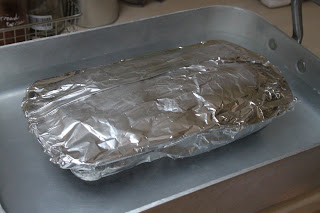 I love hot cross buns, even the cheap and nasty ones from unnameable supermarkets. Yes, I know it's a deplorable confession from one who pursues all things slow.
I love hot cross buns, even the cheap and nasty ones from unnameable supermarkets. Yes, I know it's a deplorable confession from one who pursues all things slow.But to be honest, I can't help it, and if I was honest, I am sure that I could think of at least another ten foods, where I embrace the culinary ready-made.
Food is an odd thing - its culture, history, sensory, it fills us with nostaglia and longing. That's the beauty of it. So when I surcome, it's because of a yearning for all the memories and sensations, the feeling of comfort that I get from that heavenly, ohh so heavenly combination of cinnamon, dried fruit and butter. The promise of this combination undoes me everytime, leading me to a state of non-discrimination and then disappointment.
So with Easter approaching, I am obsessing about hot cross buns and vow to myself to exercise the same discrimination that I do for every other food type! So here I go, here is a hot cross bun recipe.
Ingredients
325 gm raw caster sugar
1 lemon
1½ Granny Smith apples, unpeeled, cored, diced
1 cinnamon quill
750 gm (5 cups) plain flour - (Iused gluten-free flour)
150 gm sultanas or golden raisins
50 gm dried apple, diced 30 gm
candied orange, diced 14 gm
(2 sachets) dried yeast 3½ tsp
ground cinnamon
½ tsp allspice
Finely grated rind of 1 orange and 1 lemon
380 ml milk
100 gm butter coarsely chopped
1 egg
Preheat your oven to 220C.
Stir together 260gm sugar and 375ml water in a saucepan. Squeeze in the juice of half a lemon and stir over a medium heat until sugar dissolves. (This will be later used to glaze the chopped apple. Trust me, this is worth doing. The smell and taste is lemon fresh but equally warm and cozy.)
While the sugar and water are dissolving, cut the lemon into slices, add the Granny Smith apple and cinnamon quill. Bring to a simmer and then reduce to a medium heat. Cook until the lemon and apple are translucent. In this recipe, this is 20-25 minutes. Strain, reserving fruit and syrup separately. When cool enough dice lemon and combine with the apple.


Place in a lightly buttered bowl, cover and stand in a warm place until doubled in size. This should take 30-40 minutes.
Divide your dough into 20 even pieces, then knead each piece into a smooth ball. Arrange dough balls into two concentric circles on a large round or rectangular baking tray lined with baking paper, leaving 1cm between each for dough to expand.
Cover with a tea towel and stand in a warm place until doubled in size (30-40 minutes).
Combine remaining flour and 70ml cold water in a bowl and stir to a smooth paste. Spoon into a piping bag fitted with a small plain nozzle and pipe a cross shape onto each bun.

Take the reserved syrup and cinnamon and heat in a small saucepan until syrupy. Brush thickly over hot buns, then transfer to a wire rack to cool.
The verdict: What can I say, I don't get gluten free flour. Whatever is not in it makes a huge different to the texture, no vicosity of the dough - is that a word, she asks. The buns were heavy, almost scone like. The taste and smell were wonderful but really... really, she cries. Mr Sloweater can do his own in future.
That's it... I'm returning to the store brought!
This recipe is from the April 2010 issue of Australian Gourmet Traveller.












